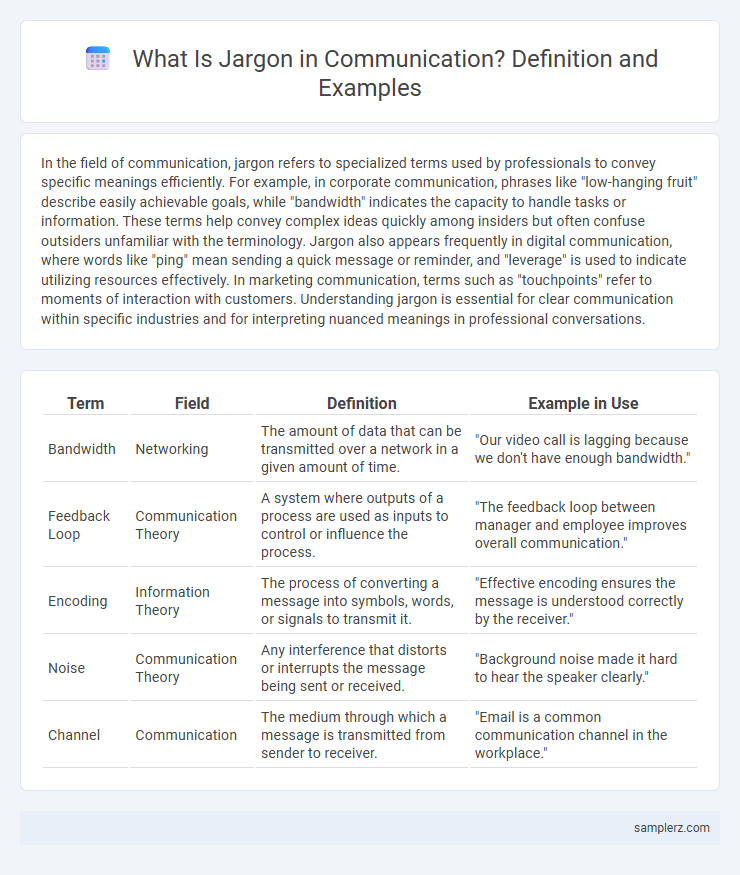In the field of communication, jargon refers to specialized terms used by professionals to convey specific meanings efficiently. For example, in corporate communication, phrases like "low-hanging fruit" describe easily achievable goals, while "bandwidth" indicates the capacity to handle tasks or information. These terms help convey complex ideas quickly among insiders but often confuse outsiders unfamiliar with the terminology. Jargon also appears frequently in digital communication, where words like "ping" mean sending a quick message or reminder, and "leverage" is used to indicate utilizing resources effectively. In marketing communication, terms such as "touchpoints" refer to moments of interaction with customers. Understanding jargon is essential for clear communication within specific industries and for interpreting nuanced meanings in professional conversations.
Table of Comparison
| Term | Field | Definition | Example in Use |
|---|---|---|---|
| Bandwidth | Networking | The amount of data that can be transmitted over a network in a given amount of time. | "Our video call is lagging because we don't have enough bandwidth." |
| Feedback Loop | Communication Theory | A system where outputs of a process are used as inputs to control or influence the process. | "The feedback loop between manager and employee improves overall communication." |
| Encoding | Information Theory | The process of converting a message into symbols, words, or signals to transmit it. | "Effective encoding ensures the message is understood correctly by the receiver." |
| Noise | Communication Theory | Any interference that distorts or interrupts the message being sent or received. | "Background noise made it hard to hear the speaker clearly." |
| Channel | Communication | The medium through which a message is transmitted from sender to receiver. | "Email is a common communication channel in the workplace." |
Understanding Jargon: Definition and Importance in Communication
Jargon refers to specialized terminology used within a particular profession or group, enhancing precise and efficient communication among its members. Understanding jargon is crucial in communication as it facilitates clarity and reduces misunderstandings when interacting with experts in fields such as medicine, technology, or law. Mastery of jargon also aids in building credibility and rapport within professional communities.
Common Workplace Jargon and Their Meanings
Common workplace jargon such as "touch base," meaning to make contact or update someone, and "circle back," indicating revisiting a topic later, frequently appear in professional communication. Terms like "bandwidth" refer to an individual's capacity to handle tasks, while "synergy" describes collaborative efforts that produce greater results. Understanding these phrases enhances clarity and efficiency in office interactions.
Technical Jargon in the IT Industry
Technical jargon in the IT industry includes terms like "API" (Application Programming Interface), "cloud computing," and "machine learning," which streamline communication among professionals by conveying complex concepts efficiently. These specialized terms often confuse clients or non-technical stakeholders, highlighting the need for clear explanations outside expert circles. Mastery of IT jargon enhances collaboration in software development, network management, and cybersecurity projects.
Medical Jargon: Terms Healthcare Professionals Use
Medical jargon includes specialized terms such as "tachycardia," "hypertension," and "myocardial infarction," which healthcare professionals use to convey precise clinical information quickly. These terms enable efficient communication among doctors, nurses, and specialists but can create barriers for patients unfamiliar with the language. Understanding and translating medical jargon into plain language improves patient comprehension and promotes better healthcare outcomes.
Legal Jargon: Words Lawyers Commonly Use
Legal jargon includes terms like "amicus curiae," referring to a person or group offering information in a case, "habeas corpus," a legal action demanding a prisoner be brought before the court, and "prima facie," indicating evidence sufficient to establish a fact unless disproved. These specific words streamline complex legal communication among lawyers and judges but often confuse laypersons in general communication settings. Understanding such jargon is crucial for effective legal dialogue and precise interpretation of court documents.
Business Jargon: Essential Terms in Corporate Communication
Business jargon includes terms like "synergy," which refers to collaborative efforts producing greater results, and "leverage," meaning to utilize resources effectively for maximum advantage. Phrases such as "bandwidth," indicating available capacity to handle tasks, and "touch base," meaning to make contact or check in, are frequently used in corporate communication. Mastery of these essential terms enhances clarity and efficiency in professional interactions.
Marketing Jargon: Popular Buzzwords Explained
Marketing jargon often includes buzzwords like "synergy," "ROI," and "brand positioning" that streamline complex communication among professionals. Terms such as "SEO," "conversion rate," and "customer engagement" are essential for targeting and measuring campaign effectiveness. Understanding this specialized vocabulary enhances clarity and efficiency in marketing strategies and collaboration.
Educational Jargon: Terms Used by Educators
Educational jargon includes terms such as "formative assessment," which refers to ongoing evaluations to monitor student learning, and "scaffolding," describing instructional techniques that support student understanding. Educators commonly use phrases like "differentiated instruction" to indicate tailored teaching approaches based on student needs. These specialized terms enhance professional communication but may confuse those outside the education field.
Avoiding Misunderstandings: When Jargon Hinders Communication
Jargon such as "bandwidth" in corporate communication can lead to confusion when team members interpret it as internet capacity rather than available time or resources. This misunderstanding slows decision-making and reduces overall efficiency during project discussions. Clear, jargon-free language ensures all participants share the same understanding, minimizing communication barriers.
Effective Communication: Translating Jargon for Clarity
Effective communication requires translating jargon such as "synergy," "bandwidth," and "touch base" into clear, accessible language that all parties understand. Using simple alternatives like "teamwork," "capacity," and "discuss" prevents misunderstandings and enhances message clarity. This approach improves collaboration by ensuring that technical or industry-specific terms do not create barriers in communication.

example of jargon in communication Infographic
 samplerz.com
samplerz.com